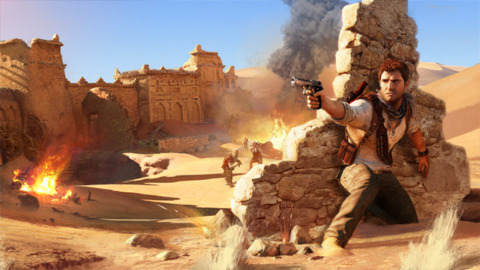3D hurdles becoming easier to leap
Developers from Uncharted 3, God of War: Origins Collection join Sony, AMD, TriOviz reps to talk about the stereoscopic singularity.
Who was there: Ready at Dawn senior programmer on God of War: Origins Collection Jeremy Nikolai, Naughty Dog Uncharted 3 lead graphics programmer Pal-Kristian Engstad, Sony Computer Entertainment Europe senior development manager Simon Benson, AMD technology management group senior manager David Nalasco, and TriOviz sales and marketing representative Guy Matteotti. The session was moderated by GameTrailers.com editor-in-chief Shane Satterfield.

What they talked about: Engstad started off by discussing the differences in developing for a 3D experience. He talked about what it brings to Uncharted's set pieces when the player feels as if the world is more real, that they could fall and actually hurt themselves, or that their plane is crashing. He did acknowledge that the extra processing power required of a 3D game is a challenge and needs to be programmed well or else players will feel that the experience suffers.
Nikolai talked about using 3D smartly for games, acknowledging that Ready at Dawn was technically "tacking it on" because they were rereleasing an existing game in 3D. But even then, he said that 3D can improve the experience if it's handled well. For God of War: Origins Collection, they originally had a problem with objects in the foreground "breaking the fourth wall" by being heavily 3D at the point they scrolled off the screen. Nikolai said the team solved the issue by tapering off the 3D effect as things approached the screen's edge, or "putting a dome over" the viewing area.
Benson said that 3D has its own set of rules. It's not just another video mode for developers; it needs to be tailored to the content as well as technical limitations in order to make the most of the experience. He said most developers have gotten up to speed with the technical side of the equation and are just now starting to explore the creative implications of 3D.
That's a front where being a part of a technology giant like Sony with multiple creative arms came in handy. Benson said that for Killzone 3, Guerrilla Games tapped the expertise of Sony Pictures for handling 3D in its cutscenes.
As for the question of 3D glasses, Benson said they're not a big problem for gaming. In addition to gamers' general comfort with peripherals, Benson said gaming tends to be a more-focused experience than watching TV. Instead of looking away from the screen or multitasking (and then feeling the need to keep taking off and putting back on the glasses), gamers tend to be locked onto the screen when they play.
Nalasco said the technological barriers are also dropping. With the speed of processors still accelerating, the technological hurdles of displaying the dual images necessary for stereoscopic 3D will be lowered. The biggest obstacle that Nalasco sees to 3D adoption is the comparatively immature state of the technology. Once the industry agrees on some standards for displays and glasses and everything gets affordable, Nalasco said 3D is going to take off. Benson noted that with the PS3, the only nonstandardized aspect is the relationship between the 3D glasses and 3D-enabled TV sets. All he said gamers need to worry about is making sure that the 3D glasses they purchase are compatible with the TVs.
Not everyone is on board with 3D gaming. When asked about third-party publishers downplaying the importance of 3D gaming, Benson noted that five years ago, everyone was still talking about the same question with HDTV adoption. Benson said that 3D is a much lower investment for developers than HD gaming, but the HD transition happened almost completely within five years. The most 3D has added to a development budget is 2 percent, Benson noted.
Engstad brought up the idea of playing in 3D as a "huge advantage" for players because they get a better sense of the battlefield and where they are going. Given how enthusiastic gamers are for any advantage they can get, Engstad said he thinks the future for the technology is bright.
Quote: "I think we're in a very good place, and in a few years' time, these questions will have gone away as they did with HD."--Benson, on the future of 3D TVs and game consoles.
Takeaway: The panel agreed on the key points for 3D, specifically that it's growing, it's going to be the future, and the hurdles it faces right now in adoption and cost are only going to be lowered.
Got a news tip or want to contact us directly? Email news@gamespot.com
Join the conversation